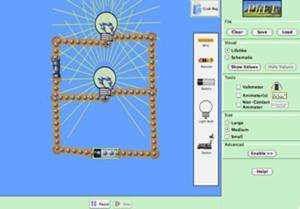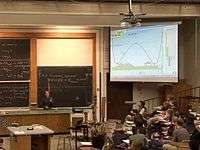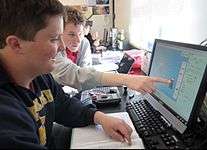PhET Interactive Simulations
PhET Interactive Simulations, a project at the University of Colorado Boulder, is a non-profit[1] open educational resource project that creates and hosts explorable explanations. It was founded in 2002 by Nobel Laureate Carl Wieman. PhET began with Wieman's vision to improve the way science is taught and learned. Their stated mission is "To advance science and math literacy and education worldwide through free interactive simulations."
 | |
 Screenshot of PhET's Circuit Construction Kit Simulation | |
Type of site | Online education |
|---|---|
| Available in | English, Afrikaans, Arabic, Brazilian Portuguese, Chinese, Danish, Dutch, Finnish, French, German, Greek, Hebrew, Indonesian, Italian, Japanese, Korean, Norwegian, Persian, Polish, Russian, Spanish, Thai, Turkish, Vietnamese |
| Created by | Carl Wieman |
| URL | phet |
| Commercial | No |
| Launched | 2002 |
Content license | Creative Commons (CC-BY) |
The project acronym "PhET" originally stood for "Physics Education Technology," but PhET soon expanded to other disciplines. The project now designs, develops, and releases over 125 free interactive simulations for educational use in the fields of physics, chemistry, biology, earth science, and mathematics. The simulations have been translated into over 65 different languages, including Spanish, Chinese, German, and Arabic; and in 2011, the PhET website received over 25 million visitors.[2]
In October 2011, PhET Interactive Simulations was chosen as the 2011 Microsoft Education Tech Award laureate.[3] The Tech Awards, presented by The Tech Museum of Innovation, honor innovators from around the world for technology benefitting humanity.[4]
History
After winning the Nobel prize in 2001, Wieman became particularly involved with efforts at improving science education and has conducted educational research on science instruction. He helped write Physics 2000[5] to provide simulations to explain his work in creating the Bose-Einstein Condensate. As he gave public lectures, some incorporating simulations,[6] he noticed that "often the simulations would be the primary thing people would remember from my talk. Based on their questions and comments, it appeared that they consistently learned the physics represented in the simulations."[7] He then used money from a grant from the National Science Foundation Distinguished Teaching Scholars program, the Kavli Foundation, and a portion of his Nobel Prize money to found PhET to improve the way that physics is taught and learned. The PhET simulations differ from the Physics 2000 ones because users can interact with the simulation to change conditions whereas the Physics 2000 simulations are just videos.[8]
In 2007, Wieman moved to Vancouver, British Columbia while retaining 20% faculty position at the University of Colorado Boulder. The current director of PhET is Dr. Katherine Perkins, who has been with PhET since January 2003. Perkins hopes that the simulations’ accessibility and interactive nature will increase scientific literacy and promote student engagement in the classroom.[9]
Organization
PhET Interactive Simulations is part of the University of Colorado Boulder which is a member of the Association of American Universities.[10] The team changes over time and has about 16 members consisting of professors, post-doctoral students, researchers, education specialists, software engineers (sometimes contractors), educators, and administrative assistants.[11] The current director of PhET is Dr. Katherine Perkins.
Design and educational impact
PhET Interactive Simulations incorporates research-based practices on effective teaching to enhance the learning of science and mathematics concepts.[12] The simulations are designed to be flexible so that they can be used as lecture demonstrations, labs, or homework activities.[13] They use an intuitive, game-like environment where students can learn through scientist-like exploration within a simplified environment, where dynamic visual representations make the invisible visible, and where science ideas are connected to real-world phenomena.
A PhET simulation starts with three to five people including a content expert (scientist), a teacher, an educational researcher, and a professional software developer. The design begins with identifying specific learning goals that have proven to be conceptually difficult based on teachers' experiences in the classroom. The simulation design, look and feel is storyboarded, discussed, and then finally "coded." Each simulation is user tested through interviews with students and in classrooms, re-worked as needed and re-tested, before released on the PhET website.[14]
Along with testing every simulation, the PhET team performs education research on their simulations. They have shown in their research that when students explore simulations in addition to traditional labs, student concept understanding improves.[15]
PhET usage by educators
While PhET Interactive Simulations develops the simulations, it is primarily teachers and publishers who develop the educational activities which use the simulations, sharing these with the community. Contributors on the PhET site follow Open Education Practices (OEP), enabling teachers to use or adapt the activities freely.[16]


Other Open Education Resource organizations that provide ideas and reviews include:
- National Science Digital Library (NSDL) provides interactive Science Literacy Maps[17] aligned to American Association for the Advancement of Science (AAAS) benchmarks with links to relevant online resources. NSDL mines metadata of collections to find online resources that match the benchmarks.[18] The collections mined are chosen based on criteria proposed by a National Research Council Steering Committee for Developing a Digital National Library for Undergraduate Science, Mathematics, Engineering, and Technology Education[19] and the validity checked regularly.[20] Teachers find PhET sims that are appropriate for specific topics by searching the maps.
- MERLOT Physics [21] uses a tiered review process to evaluate digital learning content.[22] PhET was featured as a Showcase in June 2013[23] where teachers can find teaching and learning resources that includes: Links to Member-Selected Learning Materials, Peer Reviews of High Quality Materials, and Teaching Experiences of MERLOT Members.[24]
- Physics Front[25] is a "free service provided by the AAPT in partnership with the NSF/NSDL"[26] that has about 100 ideas for using PhET[27] with editor reviews, recommended subjects, levels, resource type, appropriate courses, categories and ratings; ideas for use in units, correlation to AAAS standards; and related activities.
- Pedagogy in Action[28] provides access to a library with three elements: Teaching Methods Modules, Learning Activities, and Research on Learning Bibliography.[29] Pedagogy in Action contains an article "Resources for using PhET simulations in class – PhET Activities Database"[30] which includes summary, learning goals, context for use, description and teaching materials, Teaching Notes and Tips, Assessment, and Guidelines for developing new activities using PhET.
- iNACOL, The International Association for K-12 Online Learning[31] strategic priorities include policy advocacy, quality assurance project, and learning models. Their publications and website support a wide variety of groups which improve student personalized learning and teachers' conditions by advocating for professional development.[32] One report provides ideas for using open educational resources specifically for online learning which includes uses for PhET sims.[33]
Professional organizations also provide ideas for using PhET simulations. In the JCE Chemical Education Xchange (ChemEd X), members have blogged about how using PhET can help with specific topics like Stoichiometry Resources,[34] First Week Excitement,[35] PHYSICS 2000,[36] and Adding Inquiry to Atomic Theory.[37]
Research on use of simulations in education
The National Science Foundation has provided grants for several organizations to study PhET use:[38]
- PhET Interactive Simulations: Using Research-Based Simulations to Transform Undergraduate Chemistry Education #1226321 Principal Investigator:Katherine Perkins; Co-Principal Investigator:Robert Parson; Organization:University of Colorado at Boulder; 09/15/2012
- Expanding PhET Interactive Science Simulations to Grades 4-8: A Research-based Approach #1020362 Changing how physics students approach learning with simulations: Research and development of PhET-based tutorials #1245400 Principal Investigator:Katherine Perkins; Co-Principal Investigator:Michael Dubson, Daniel Schwartz, Noah Podolefsky; Organization:University of Colorado at Boulder; 09/01/2010
- Physics Education Research User's Guide: A Web Resource for Physics Educators #1245490 Principal Investigator:Andrew Elby; Co-Principal Investigator:Ayush Gupta; Organization:University of Maryland College Park; 06/15/2013
- Physics Education Research User's Guide: A Web Resource for Physics Educators #1245490; Principal Investigator:Sarah McKagan; Co-Principal Investigator:Bruce Mason, Beth Cunningham; Organization:American Association of Physics Teachers;05/01/2013
- Physics Education Technology Project #0442841 Principal Investigator:Carl Wieman; Co-Principal Investigator:Noah Finkelstein, Katherine Perkins; Organization:University of Colorado at Boulder;06/01/2005
- Physics and Chemistry Education Technology Project #0817582; Principal Investigator:Katherine Perkins; Co-Principal Investigator:Michael Dubson, Noah Finkelstein, Robert Parson, Carl Wieman; Organization:University of Colorado at Boulder;08/01/2008
- Expanding PhET Interactive Science Simulations to Grades 4-8: A Research-based Approach #1020362; Principal Investigator:Katherine Perkins; Co-Principal Investigator:Michael Dubson, Daniel Schwartz, Noah Podolefsky; Organization:University of Colorado at Boulder;09/01/2010
- The Physics of Everyday Life: Java Applets and Interactive Lecture Demonstrations for Non-science Students #0123561; Principal Investigator:Carl Wieman; Co-Principal Investigator:; Organization:University of Colorado at Boulder;09/01/2001
Other research grants:
References
- Support PhET
- Guttenplan, D.D. (December 11, 2011). "Web Tutors Become Stars Far from Classroom". New York Times.
- "The Tech Award 2011". Archived from the original on 2012-11-09.
- McCracken, Harry (October 21, 2011). "Meet the Winners of This Year's Tech Humanitarian Awards". Time.
- "Physics 2000". University of Colorado Boulder. Archived from the original on 24 September 2014. Retrieved 22 August 2013.
- Cornell, E.A.; C.E. Wieman (2002). "Nobel Lectures in Physics 2001". Rev. Mod. Phys. 74 (3): 875–893. doi:10.1103/revmodphys.74.875.
- Wieman, Carl; Katherine K. Perkins; Wendy K. Adams (April 2008). "Oersted Medal Lecture 2007: Interactive simulations for teaching physics: What works, what doesn't, and why". American Journal of Physics. 76 (4): 393. doi:10.1119/1.2815365.
- "Reviews Web Watch- Interactive Simulations" (PDF). 2005 Phys. Educ. 40 81. IOP Publishing. Retrieved 22 August 2013.
- Xue, Katherine (July–August 2012). "Alumni Science Simulator". Harvard Magazine. Retrieved 22 August 2013.
- "Association of American Universities".
- "About PhET".
- Bryan, Joel (June 2006). "Technology for Physics Instruction". Contemporary Issues in Technology and Teacher Education. 6 (2): 230.
- Ash, Katie. "Programming Digital Fun Into Science Education". Education Week Digital Directions.
- Maki, Peggy (2004). Assessing for Learning: Building a Sustainable Commitment Across the Institution. Sterling, VA: Stylus Publishing. ISBN 1579224407.
- Wieman, Carl; Wendy K. Adams; Katherine K. Perkins (October 2008). "PhET Research: Simulations that Enhance Learning". Science. 322 (5902): 682–3. doi:10.1126/science.1161948. PMID 18974334.
- "PhET For Teachers". PhET Interactive Simulations. Retrieved 23 June 2013.
- "National Digital Science Literacy Maps". Retrieved 16 June 2013.
- Dushay, Naomi (2003). Analyzing metadata for effective use and re-use. Proceedings of the International Conference on Dublin Core and Metadata Applications. CiteSeerX 10.1.1.210.8888.
- Developing a Digital National Library for Undergraduate Science, Mathematics, Engineering and Technology Education: Report of a Workshop. Washington, DC: The National Academies Press. 1998. pp. 53–57. ISBN 978-0-309-05977-0.
- Kyrillidou, Martha (2005). Developing the DigiQUAL protocol for digital library evaluation. In Proceedings of the 5th ACM/IEEE-CS Joint Conference on Digital Libraries: ACM Press. pp. 172–173.CS1 maint: location (link)
- "MERLOT Physics". MERLOT at California State University. Retrieved 21 June 2013.
- Advances in Web-Based Learning - ICWL 2004: Third International Conference, Beijing, China, August 8–11, 2004, Proceedings, Volume 3 (Google eBook)
- "MERLOT Physics Showcase". MERLOT at California State University. Retrieved 16 June 2013.
- "MERLOT Physics". MERLOT at California State University. Retrieved 16 June 2013.
- "Physics Front". AAPT and NSF-NSDL. Retrieved 21 June 2013.
- "The Physics Front". AAPT and NSF-NSDL. Retrieved 16 June 2013.
- "Physics Front". search for phet activities. AAPT and NSF-NSDL. Retrieved 16 June 2013.
- "Pedagogy in Action". Science Education Resource Center @ Carlton College. Retrieved 21 June 2013.
- "Pedagogy in Action Library". Science Education Resource Center @ Carlton College. Retrieved 16 June 2013.
- "Resources for Using PhET in class". Science Education Resource Center @ Carlton College. Retrieved 16 June 2013.
- "The International Association for K-12 Online Learning". Retrieved 23 June 2013.
- Vander Ark, Tom (June 17, 2013). "10 Ways Smart Cities Develop & Support Teachers". Education Week. Retrieved 23 June 2013.
- "Open Educational Resources and Collaborative Content Development – A Practical Guide for State and School Leaders" (PDF). iNACOL. Archived from the original (PDF) on 25 February 2015. Retrieved 23 June 2013.
- Cullen, Deanna. "Stoichiometric Resources". Division of Chemical Education. Retrieved 16 June 2013.
- Cullen, Deanna. "First Week Excitement". Division of Chemical Education. Retrieved 16 June 2013.
- Cullen, Deanna. "PHYSICS 2000". Division of Chemical Education. Retrieved 16 June 2013.
- Cullen, Deanna. "Adding Inquiry to Atomic Theory". Division of Chemical Education. Retrieved 16 June 2013.
- "awards". search PhET. National Science Foundation. Retrieved 22 August 2013.
External links
- PhET Interactive Simulations
- YouTube Video from The Tech Award on PhET Interactive Simulations